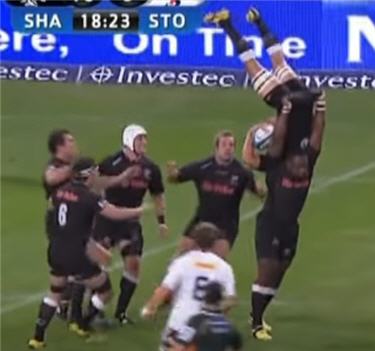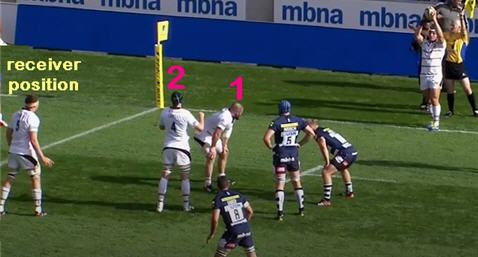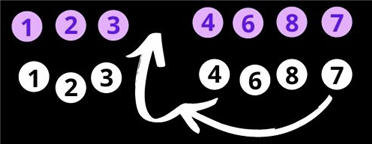A lineout must have at least two players from each team, although it’s very rare to see such a short formation.
There is no maximum number in the rulebook. A thirteen-player lineout is unusual, but this article will show you several examples in international matches.
We’ll also review the most common formations, and explain the advantages and disadvantages.
How Many Players In A Lineout?
Most lineouts in rugby have five or six players per team. Over 70% of lineouts in the 2021 Six Nations Championship had these numbers.
A lower percentage of lineouts have seven players, with about 24% across the 2021 Six Nations.
Two or three-player lineouts are rare in rugby.
Detailed breakdown of the 2021 Six Nations
Here is a detailed breakdown using statistics from the 2021 Six Nations:
| 4 Players | 5 Players | 6 Players | 7 Players |
| 4% | 37% | 35% | 24% |
There was one three-player lineout across all fifteen matches of the championship.
No match had a two-player lineout.
What Is The Most Number Of Players Allowed In A Lineout?
The laws of Rugby Union don’t specify a maximum number of players in the lineout.
Most lineouts have a player standing two meters back to receive the ball. However, this isn’t mandatory.
As a lineout can’t take place without a player throwing in the ball, this means that the maximum number is fourteen.
I’ve never seen or heard of a fourteen-player lineout in a match. However, thirteen-player lineouts occasionally crop up – even in elite international matches.
Thirteen-Player Lineouts
Warren Gatland has coached Ireland, Wales, and the British & Irish Lions.
Before he took the reins of the Irish national team, he coached at club level at Connacht Rugby Club.
Connacht vs Australia, early 1990s
I’ve read reports that Gatland deployed the 13-player lineout for the first time when Australia toured Ireland and played a club match against Connacht.
This was possibly in 1992, but I can’t find any footage.
However, I know another time all too well when a Gatland team tried to pluck a rabbit out of a hat this move.
Ireland vs Argentina
Gatland coached Ireland in the 1999 Rugby World Cup. Their loss to Argentina would lead to the New Zealander moving on to Wales.
In the final minutes of the match, Ireland needed a try to win. With a throw-in near the Argentina try line, they put thirteen players into the lineout.
The goal of a 13-player lineout is to start a powerful maul and drive over the try line.
The problem is that if the maul is stopped, there are no players in open field to initiate another attacking play.
This is exactly what happened. The Pumas held out and closed out the win. You can see the formation in the second half of this short video.
The first half of the video has a successful example of Gatland’s move. This was later when he coached Wales.
Wales vs All Blacks
Gatland’s Wales pulled the rabbit out of the hat against the All Blacks in an Autumn international in 2012.
With a lineout close to the All Blacks try line, Wales put thirteen players into the line.

The All Blacks left several players in open field. That included Richie McCaw, the captain.
It seems that the all-time great had never seen the formation and was caught completely by surprise.
Without calling players to defend the ensuing maul (or go in himself), McCaw watched as Wales outnumbered the defenders and drove over the try line (you can check out the video).
Two-Player Lineouts
All lineouts must have at least two players from each team. This is the minimum specified in the laws of Rugby Union.
It’s extremely rare for a team to use a two-player lineout.
The official statistics from the 2021 Six Nations showed there were no lineouts with only two players.
Think about lifting in the lineout. Although it’s possible to hoist a player up with one lifter assisting the jump, it’s very difficult to bring the jumper down safely.
Here’s a grainy photo of Tendai Mtawarira (The Beast) lifting a teammate who was jumping to catch the kick-off.

It’s only The Beast’s immense strength that prevented the player from landing on his head.
However, there is one clever solution I can show you.
One example of a two-player lineout
Up until I was researching this article, I’d never seen a two-player lineout in a professional fifteens rugby match. And that’s from over thirty years of enjoying the sport.
After a bit of internet searching, I dug up an example from English club rugby.
Wasps put two players into the lineout and another forward in the receiving scrum-half position.

The throwing team’s scrumhalf is often stood in the receiver position. But in this case, a big burly lock is standing at receiver.
There’s a good reason for this. As the hooker throws in the ball, the lock races forward and acts as the second lifter for the player jumping at number 2. You can see what happens in this video.
This is a tricky move to pull off because of the laws around lineouts. The player in the receiver position has to stand two meters away. He can’t move forward until the hooker starts to throw.
Three-Player Lineouts
Three-player lineouts are as rare as hens’ teeth, but they do happen.

There was one single example across the fifteen matches in the 2021 Six Nations. It was in the match between Italy and France.
I also spotted one in the opening round of the 2022 Six Nations between Scotland and England.
Scotland flung the ball high over the top of the three-player lineout. A flanker standing outside the lineout rushed forward to catch the ball.
Scotland were on their own line and it’s quite a risky move. But it meant they had the ball further infield from the touchline, making it easier for a longer box kick into touch.
Four-Player Lineouts
Four players in a lineout is a very common formation, although not quite as common as five players.
You may hear commentators refer to it as a “shortened” lineout.
Advantages of a four-player lineout
Having four players in the lineout lets you put three beefy forwards into the midfield ready to bash into the opposition’s backline.
It’s also a tactic when your team has a lineout within their own twenty-two.
Because there are fewer forwards close to the ball, the scrumhalf or flyhalf may be under less pressure when clearing it.
Disadvantages of the shortened lineout
Calling a full or seven-player lineout ensures that the opposition forwards are bunched on one side of the pitch.
This makes the open field less cluttered for the backs to run their fancy-dan moves.
In contrast, a four-player lineout allows the opposition to put one or two flankers into the defensive line. This makes attacking play more challenging.
Five-Player Lineouts
This is the most common formation, although it’s only slightly more common than the six-player lineout.
The five-player formation allows for having two potential jumpers. Each will have one lifter beside them.
But shouldn’t there be two lifters? Yes, the fifth player will shift position to be the second lifter for either jumper.
You can probably see one disadvantage here. Experienced opposition forwards will try to use the fifth player’s movements to anticipate who is going to be lifted.
The way to counteract this is for every player to use some movement before the ball is thrown in. That’s why players can seem a little hyperactive in the lineout, darting backward and forward.
Six Player Lineouts
Six players in the lineout mean that there can be two jumpers with each having two lifters.
Two pods of three can go through the motions of jumping for the ball. It’s more difficult for the opposition to predict which one will get it than with the five-player version.
Six-Plus-One Lineout
The traditional six-player lineout has the scrum-half standing two meters back in the receiver position.
The popular six-plus-one variation has the seventh forward standing in the scrum-half position to receive the ball.
This allows the extra forward to quickly join a maul.
Of course, the opposition can see this formation and will have to prepare for a maul.
The six-plus-one is also a good way to disguise an alternative play such as throwing long and getting the ball out into the open field.
Seven-Player Or “Full” Lineouts
A lineout with seven players is also referred to as a “full” lineout. All the forwards are in the line apart from the hooker.
Despite the name, don’t be mistaken in thinking that seven is the maximum number allowed in a lineout. There is no law against backs being in a lineout.
Like the six-player lineout, the seven-player version allows for two jumping pods. In other words, each pod has one jumper and two lifters.
But the seventh player allows for extra moves.
Loop play
One rare move is very slick when it’s pulled off. The first pod moves forward and the second pod moves backward. Both pods lift their jumper.
The opposition forwards follow the movements of the nearest pod. This causes a gap in the middle.

The jumper in the pod at the back catches the ball and hands it off to the tail gunner in position number 7. This player loops around to race through the gap.
The All Blacks ran this one in a World Cup match against France.
More About Lineouts
Check out these articles: